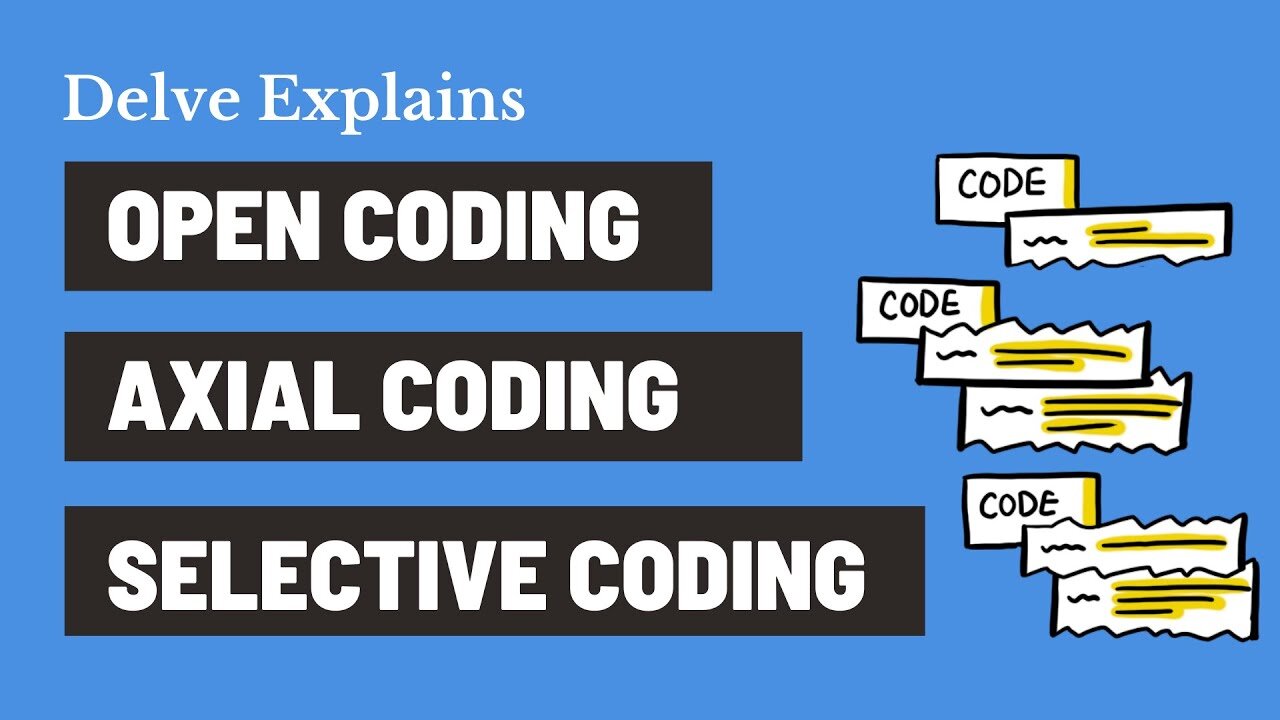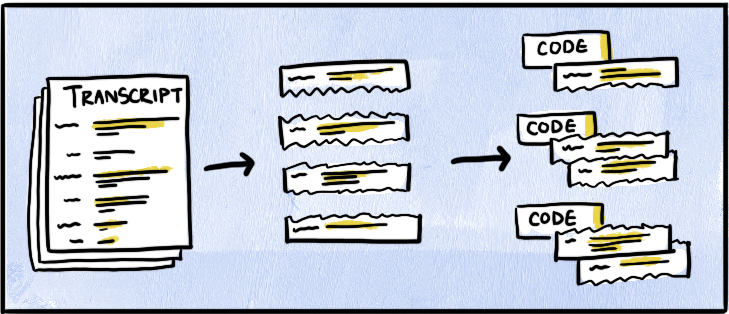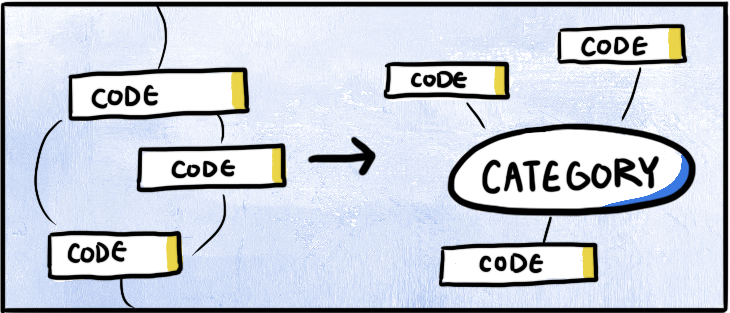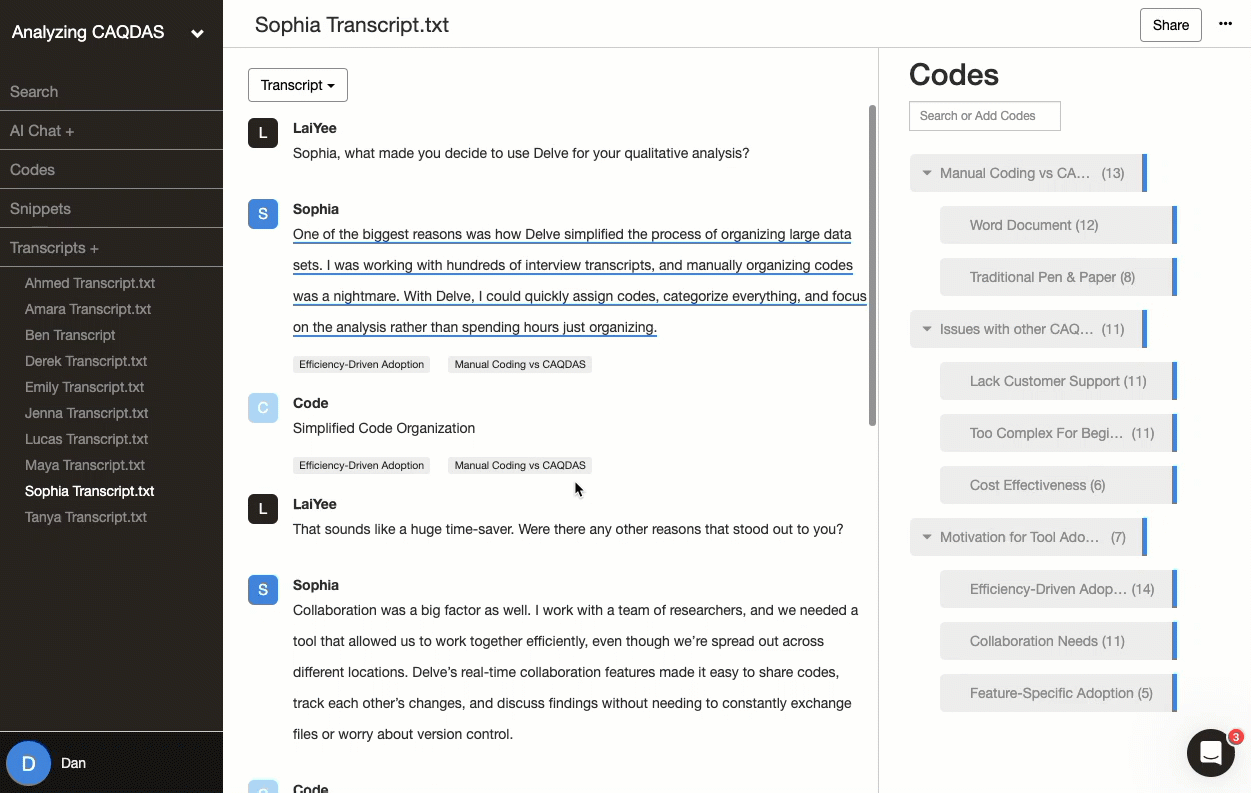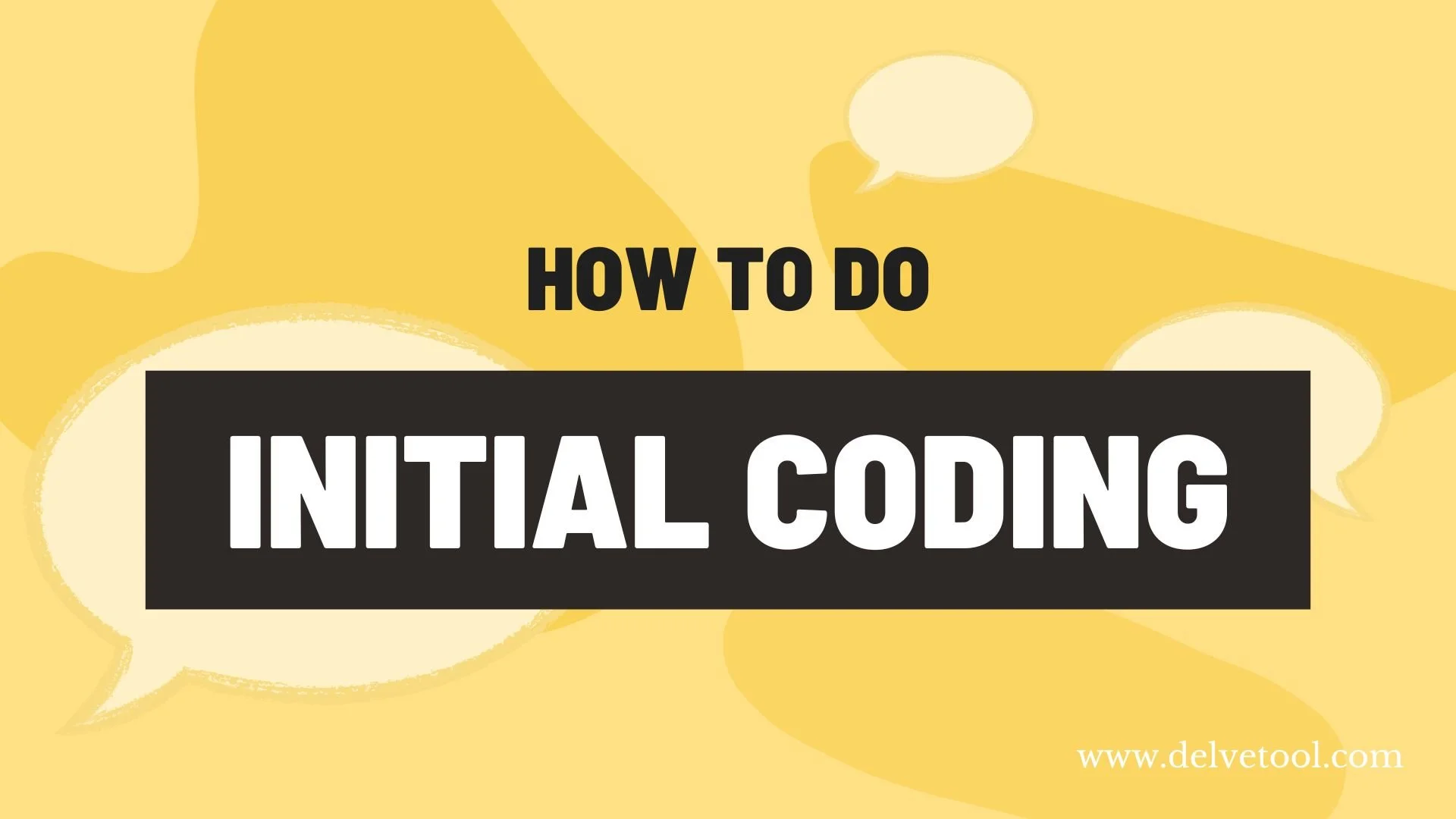Open, Axial, and Selective Coding in Qualitative Research: A Practical Guide
Open, axial, and selective coding offer a three-pronged strategy that guides your journey from a labyrinth of raw data to coherent research gold.
Open, axial, and selective coding are interconnected steps in qualitative data analysis. A cornerstone of grounded theory, you use these coding methods at different stages of your analysis to progressively crack the code buried in your mountain of transcripts and field notes.
Let’s walk through open, axial and selective coding, showing how they manage the overwhelming process of qualitative research. We'll also show how Delve’s computer assisted qualitative data analysis software (CAQDAS) helps avoid many of the usual sticking points along the way.
JUMP TO SECTION:
ℹ️ If you’re new to qualitative coding or need a refresher, check out our Essential Guide to Coding Qualitative Data or take our Free Qualitative Coding Course for Beginners.
The Building Blocks of Open, Axial, and Selective Coding
Before diving into the specifics of these three methods, let’s quickly cover the concept of coding itself. A code in qualitative analysis is a label or tag you apply to meaningful data points, such as excerpts from interview transcripts or observational research.
For example, if you were doing a study about workplace stress, you might assign the code "Long Hours" to the following transcript excerpt:
Although I try to pace myself, there are periods when work demands push me to go beyond a typical schedule. "I often find myself working late into the night, which leaves me feeling exhausted and irritable the next day." It’s not just about finishing tasks but also feeling the need to constantly prove I’m fully committed.
CODE – Long Hours
These individual codes are the foundation for your broader analytical work ahead. However, “tagging” your data only takes you so far and can get unmanageable without a plan. While you have many qualitative coding techniques at your disposal, open, axial and selective coding offer a framework for managing, organizing, and thinking about your code in a more strategic way.
Rather than drowning in endless codes and tangents, this triad of coding methods paves the path from your initial observations to overarching theoretical breakthroughs.
Connecting the Dots for Your Grounded Theory
As the backbone coding in grounded theory, open, axial, and selective coding help you unearth new theories from your data. Instead of using them to confirm existing information, these inductive coding methods help you discover new theories buried in interviews and other data. There is no roadmap. You’re creating one along the way.
Picture it like mining for gold. Each method plays a crucial role:
Open Coding: You’re breaking ground, examining every piece of data for potential.
Axial Coding: You’re tracing gold streaks, connecting related data into meaningful patterns.
Selective Coding: You’re following the richest vein to strike gold–your core theory.
While you're steadily moving toward your final theory, remember that grounded theory is iterative. You'll cycle back and forth through these stages, but dive deeper with each pass. You continue doing this until new information stops adding new insights to your study – a spot called "theoretical saturation." It's a time-intensive process, but tools like Delve are built for digging deep into your data (in less time).
When to Use Open Coding, Axial Coding, and Selective Coding
You want to follow a grounded theory method of qualitative analysis
You want to derive new theories or concepts from your data
You don’t want preconceived theories to determine the outcome of your research
You are conducting exploratory research where you want to generate new concepts and ideas
📌 Coding Tip: The strength of grounded theory is its ability to explain a topic based only on the data itself. New to grounded theory? Check out our Practical Guide to Grounded Theory or watch our short explainer video to learn more.
Open, Axial, and Selective Coding: A Grounded Theory Coding System
Keeping that brief overview in mind, let's take a closer look at what goes into (and separates) open, axial, and selective coding based on the formative work of Corbin and Strauss (1990).
Open Coding: Finding New Theoretical Possibilities
What is open coding in qualitative research❓ Open coding is your first step in making sense of your data. It's about breaking down piles of data into manageable pieces and starting to identify salient patterns that really stick out to you.
Corbin and Strauss paint the process as digging up “concepts, properties, and dimensions within the data" (p. 12). The goal is to “open” you up to these new theoretical possibilities right when starting off with your data, not simply to organize it. Writing notes or memos helps you track these ideas and connections as you create them.
So, at this initial stage in your analysis, open coding (also called initial coding) helps you identify fresh patterns as you first embark on your larger pattern-seeking mission.
📌 Coding Tip: Keep memos about why you grouped codes together to track your thoughts and support insights in your write-up. This makes for more consistent coding and better coding discussions during collaborative qualitative analysis.
What You'll Do in Open Coding:
Read through your data carefully.
Break the text into small, meaningful segments (these could be words, phrases, or sentences).
Assign a code (a short descriptive label with a clear definition) to each segment.
Suggested: Record memos and attach them to your codes using a tool like Delve.
The purpose of breaking up your data and labeling them with codes is to continuously compare and contrast similar events in your data. This pattern-seeking process, called the constant comparison method, forces you out of preconceived ideas about your subjects. By systematically comparing each piece of coded data against others, you begin to see connections that might otherwise remain hidden.
💡 Best Practice: The constant comparison process ensures that your theory is grounded in the data rather than any preconceived opinions or notions. Try using it throughout all three coding phases, starting in open coding, where you compare data segments to each other as you assign codes.
OPEN CODING EXAMPLE
Let's say you're researching work-life balance in the relatively new phenomenon of remote working environments. Here's an snippet from an interview with Natasha, a respondent in your study:
“I try to keep a balance between my work and personal life, but I'm always checking work emails at home. It feels like I'm never really off the clock, and it's annoyingly hard to switch off, you know? Sometimes I feel like my mind is still at work even when I'm with family. I do try to set clear boundaries, though. For instance, like no phone during dinner. But it's a struggle to stick to these boundaries consistently.”
Work-Life Balance Transcript (Open Coding)
I try to keep a balance between my work and personal life, but I'm always checking work emails at home. It feels like I'm never really off the clock, and it's annoyingly hard to switch off, you know? Sometimes I feel like my mind is still at work even when I'm with family. I do try to set clear boundaries, though. For instance, like no phone during dinner. But it's a struggle to stick to these boundaries consistently.
OPEN CODES:
- Work Intrusion - Work-related activities penetrating personal time/space
- Difficulty Disconnecting - Challenges in mentally separating from work
- Boundary Setting - Attempts to create work-life divisions
- Specific Boundary Tactics - Concrete strategies used to maintain boundaries
📌 Coding Tip: Delve CAQDAS helps you manage your codebook and track open, axial, and selective codes, all while keeping everything centralized in one web-based location. This makes it easy to seamlessly transition between coding phases without losing track of your key insights.
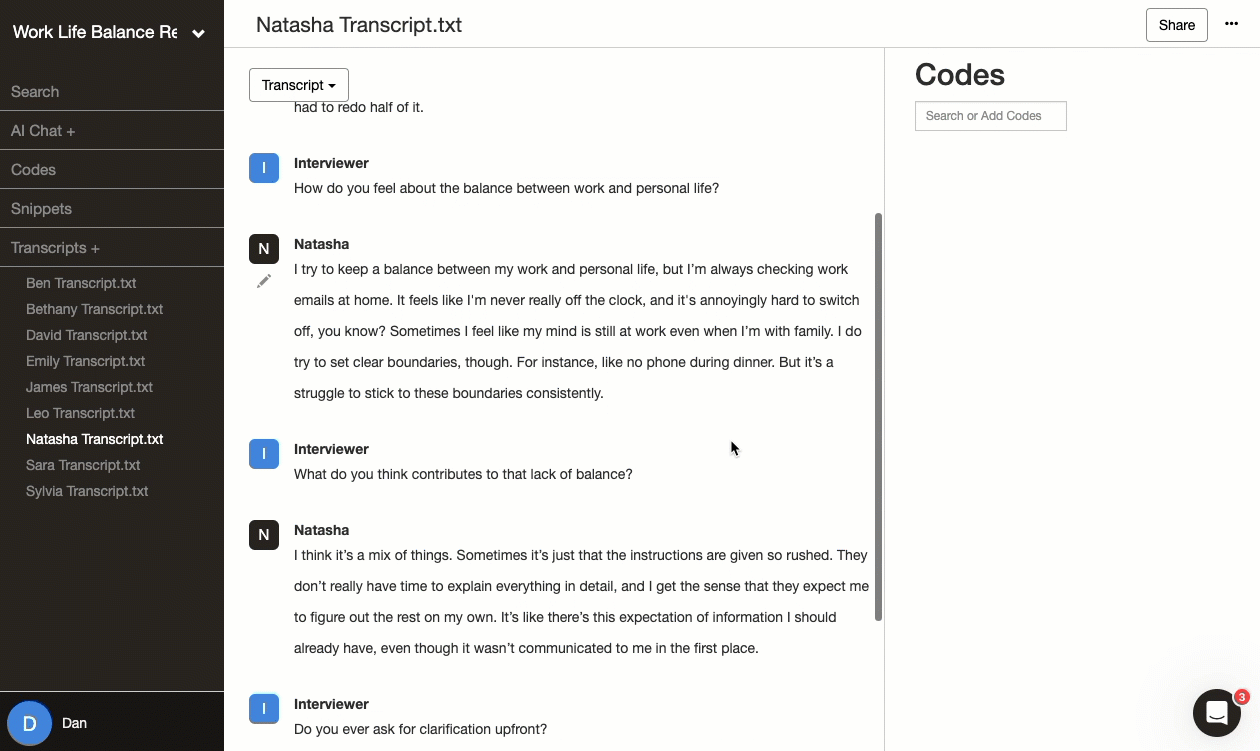
Axial Coding: Mapping Out Connections
What is axial coding in qualitative research❓After breaking everything down through open coding, axial coding helps you rebuild it in meaningful ways to explain something new about it all. Axial coding is where you start seeing how different pieces of your data connect and influence each other – like pieces in a puzzle. These connections form broader categories, or themes, that help explain what's really going on in your data.
Think of categories as the major plot points in your research story. They become the 'axes' or central points that help organize your understanding and link ideas together.
What You'll Do in Axial Coding:
Review your open codes.
Look for connections or relationships between codes.
Group related codes into broader categories.
Consider how these categories might be linked.
This step is about moving you from describing what you see to understanding how it all works together. You’re tracing gold dust back to the real pay dirt – where your core theory waits to be unearthed.
Instead of just having a bunch of disjointed pieces, you're building the bigger picture of how all the pieces interact, group together, and influence each other.
💡 Best Practice: Remember that this process isn't set in stone. You'll likely cycle through several coding rounds, and that’s okay! Continuously comparing, contrasting, and refining your categories as you dig deeper into your analysis leads to more rigorously developed results.
AXIAL CODING EXAMPLE
Continuing with our work-life balance example, you might start seeing deeper patterns in your initial codes. Here's how you could cluster those earlier codes, along with additional related ones for the purpose of this example, into more robust categories:
Axial Coding: Work-Life Balance Analysis
Category: Cost of Constant Connectivity
This category explores the toll of constant digital engagement on personal well-being and identity.
- Work Intrusion - Constant work-related engagement encroaching on personal life.
- Difficulty Disconnecting - Challenges in mentally and physically detaching from work.
- The "Always Available" Expectation - Implicit or explicit expectation to be always reachable.
- Digital Fatigue - Exhaustion resulting from prolonged digital interaction.
- Unseen Emotional Toll - Emotional strain that accumulates unnoticed over time.
- Blurred Personal Space - Lack of clear boundaries between work and personal environments.
- Encroachment on Personal Identity - Work demands impacting one’s sense of self and identity.
- Eroded Personal Time - Reduction of leisure time due to work-related obligations.
Category: The Art and Struggle of Boundary Management
This category reflects strategies individuals employ to manage and protect personal boundaries in a digital-first work culture.
- Boundary Setting - Establishing rules to separate work and personal time.
- Specific Boundary Tactics - Actions taken to enforce boundaries, like no phone during meals.
- Defining "Off-Hours" - Setting clear non-work hours for personal time.
- Resisting Digital Intrusion - Actively avoiding digital engagement during personal time.
- Carving Out Quiet Time - Designating time for reflection or relaxation away from screens.
- Creating Emotional Guardrails - Emotional ways to maintain resilience against work stress.
- Self-Imposed Limits - Setting personal rules to limit work engagement.
- Prioritizing Non-Work Activities - Focusing on hobbies and interests outside of work.
These categories build upon initial open coding insights while fleshing out deeper patterns. The first category captures the various impacts of constant connectivity, while the second explores both reactive and proactive boundary-setting strategies.
Through axial coding, you begin to see how these categories might interact – perhaps how increasing costs of connectivity drive more sophisticated boundary management techniques, or how weak boundaries intensify connectivity costs.
The challenge of axial coding is that it requires you to think abstractly about your data and identify sometimes subtle relationships. Nesting is a useful approach here, where top-level categories cluster your open codes together in meaningful ways. Creating this hierarchy helps clarify the relationships between them.
📌 Coding Tip: Delve's nesting feature lets you drag and drop codes into categories, making axial coding more intuitive and flexible. You can easily move and reorder codes as you build your analysis.

Selective Coding: Identifying the Core Concept
What is selective coding in qualitative research❓ Selective coding is where everything comes together. After breaking down your data and finding connections, this final stage helps you identify the central theme that unifies all your categories. This core theme becomes the foundation of your theory and your main explanation about what's really happening in your research. Here's where you zoom way out and try to see the forest for the trees.
What You'll Do in Selective Coding:
Review your categories from axial coding.
Spot the central category that keeps appearing and connects to others
Link all other categories to this core theme
Refine your categories and their relationships.
Landing on your core theme should feel like you've struck gold. It’s your that "aha" moment when everything clicks into place like your final puzzle piece. Through constant comparison, you'll build your theory from the ground up. When you can explain your grounded theory in a few strong sentences, you'll know you're on the right track.
💡 Best Practice: It's important to test your core concept by revisiting your data regularly. Don’t rush this process. Try explaining your core theme to someone unfamiliar with your research or a peer debriefer. If they understand it clearly, you’re likely on the right track. Also, ensure that your core concept isn’t too broad. It should be specific enough to give your theory direction, but flexible enough to encompass all the key findings from your categories.
SELECTIVE CODING EXAMPLE
Returning to our work-life balance study, careful analysis reveals a core category that ties everything together: "The Quiet Erosion of Self in the Age of Unchecked Work." This theme ties together the impact of constant digital availability with individual efforts at boundary-setting, revealing a cumulative effect on personal identity.
Selective Coding Example: Developing the Core Concept
Building on Earlier Categories
- Cost of Constant Connectivity - This category explores the toll of constant digital engagement on personal well-being and identity.
- The Art and Struggle of Boundary Management - This category reflects strategies individuals employ to manage and protect personal boundaries in a digital-first work culture.
This core category shows that constant connectivity subtly erodes personal boundaries and identity, as people attempt (but often struggle) to protect their personal space. "The Quiet Erosion of Self in the Age of Unchecked Work" flags the widespread nature of this challenge and the limitations of boundary-setting as a solution. Each code and category from previous stages supports this narrative of identity erosion and resistance in a digital-first work culture.
Articulating the Grounded Theory
"In remote work environments, the erosion of self occurs not through dramatic workplace demands, but through subtle, persistent digital encroachment that slowly reshapes workers' sense of self and space. While workers develop boundary management strategies, these often serve more as coping mechanisms than true solutions to the underlying identity erosion."
Through selective coding, you've developed a powerful insight: Digital presence and boundary management create a 'quiet' erosion of identity in remote work - quiet because it's gradual, unnoticed, yet relentlessly systematic. What began as a hypothesis about workplace boundaries becomes, through your analysis and coding, evidence of a subtle but persistent wearing away of self.
📌 Coding Tip: Managing codes across large datasets can be overwhelming, especially when trying to keep track of relationships and patterns within them. With Delve’s intuitive interface, you can filter, organize, and refine codes as you go, maintaining a clear structure in your analysis without losing sight of key insights.
Step-by-Step Guide: Open, Axial, and Selective Coding
FRAMING: QUESTIONS TO ASK IN OPEN CODING
- What is happening in this section?
- What actions are taking place?
- What is this person/data really saying?
- What seems to matter most here?
- How does this connect to my research questions?
- What assumptions am I making that I need to check?
FIRST READ-THROUGH
Read your transcript or field notes without coding, just to get familiar
Use Delve's memo feature to jot down initial thoughts and potential patterns
Highlight any quotes that jump out as particularly meaningful
Here is the uncoded segment we’ll focus on
Work-Life Balance Transcript
NATASHA: "I try to keep a balance between my work and personal life, but I’m always checking work emails at home. It feels like I'm never really off the clock, and it’s annoyingly hard to switch off, you know? Sometimes I feel like my mind is still at work even when I’m with family. I do try to set clear boundaries, though. For instance, like no phone during dinner. But it’s a struggle to stick to these boundaries consistently."
START LINE-BY-LINE CODING
Begin Line-by-line coding to avoid jumping to conclusions about larger sections
Work through small chunks (2-3 sentences) at a time to stay focused and catch key details
Try to create codes that capture the meaning and action, not just obvious, surface-level descriptions
Work-Life Balance Transcript (Open Coding)
I try to keep a balance between my work and personal life, but I'm always checking work emails at home. It feels like I'm never really off the clock, and it's annoyingly hard to switch off, you know? Sometimes I feel like my mind is still at work even when I'm with family. I do try to set clear boundaries, though. For instance, like no phone during dinner. But it's a struggle to stick to these boundaries consistently.
OPEN CODES:
- Work Intrusion - Work-related activities penetrating personal time/space
- Difficulty Disconnecting - Challenges in mentally separating from work
- Boundary Setting - Attempts to create work-life divisions
- Specific Boundary Tactics - Concrete strategies used to maintain boundaries
💡 Best Practice: When working with interview transcripts, consider not just the words, but also the context behind them. Details like hesitation, tone, repetition, or phrasing can signal uncertainty or deeper emotions. For example, if a participant repeatedly mentions trying to "set boundaries," it could reflect an ongoing struggle, even if the words seem straightforward. Keeping track of these subtleties can lead to more nuanced coding and richer insights into their experiences.
BUILD YOUR INITIAL CODE LIST
Keep codes as simple and clear as possible
Write codes as actions (e.g., "Boundary Setting" rather than just "Boundaries")
Use Delve to create your codebook and track code definitions and examples
Record why you created each code using memos, which tracks your thought process and allows you to view their evolution
Review your codes after every 2-3 transcripts to check for overlap. This helps you apply codes consistently and prevents redundant codes from bottlenecking.
As you refine your codes, you'll start to see which ones are capturing the most relevant themes across multiple interviews.
📌 Coding Tip: Staying organized is essential when managing dozens or hundreds of codes, and it can quickly become challenging without the right tools. Delve's code management features allow you to easily organize, filter, and adjust codes, keeping your coding process efficient and streamlined.
PHASE II - AXIAL CODING (FINDING CONNECTIONS)
Framing: Questions to Ask in Axial Coding
- How do these codes relate to each other?
- What conditions lead to this happening?
- What are the consequences when this happens?
- What patterns keep showing up?
- What bigger story might these codes tell together?
- Are there codes that seem to conflict - and why?
GROUP SIMILAR CODES
Look for codes that seem to be talking about the same bigger idea
Create categories that capture these related codes
Use Delve's nesting feature to organize codes within categories
MAP OUT RELATIONSHIPS
Create hierarchies to identify higher-level concepts vs. subcategories
Draw simple diagrams showing how categories might connect
Use data visualization tools, like those included with Delve software
Look for cause-and-effect relationships
Note which categories frequently appear together
💡 Best Practice: Exploring cause-and-effect relationships between codes can deepen your analysis and reveal valuable insights. In our work-life balance study, these relationships help illustrate how codes interact:
- Work Intrusion might lead to Difficulty Disconnecting, which could increase the need for Boundary Setting.
- Difficulty Disconnecting could elevate Stress Levels, prompting Coping Mechanisms like relaxation techniques.
- Effective Boundary Setting might reduce Difficulty Disconnecting and lead to improved Work-Life Balance.
Mix and match different codes and categories to uncover richer insights and understand how various elements interact.
REFINE YOUR CATEGORIES
Write clear definitions for each category
Re-check if all your codes fit well within their categorical hierarchies
Be willing to iterate, rearrange, or rename as needed
Axial Coding: Work-Life Balance Analysis
Category: Cost of Constant Connectivity
This category explores the toll of constant digital engagement on personal well-being and identity.
- Work Intrusion - Constant work-related engagement encroaching on personal life.
- Difficulty Disconnecting - Challenges in mentally and physically detaching from work.
- The "Always Available" Expectation - The expectation to be reachable at all times.
- Digital Fatigue - Exhaustion resulting from prolonged digital interaction.
- Unseen Emotional Toll - Emotional strain that accumulates unnoticed over time.
- Blurred Personal Space - Lack of clear boundaries between work and personal environments.
- Encroachment on Personal Identity - Work demands impacting one’s sense of self and identity.
- Eroded Personal Time - Reduction of leisure time due to work-related obligations.
Category: The Art and Struggle of Boundary Management
This category reflects strategies individuals employ to manage and protect personal boundaries in a digital-first work culture.
- Boundary Setting - Establishing rules to separate work and personal time.
- Specific Boundary Tactics - Actions taken to enforce boundaries, like no phone at meals.
- Defining "Off-Hours" - Setting clear non-work hours for personal time.
- Resisting Digital Intrusion - Actively avoiding digital engagement during personal time.
- Carving Out Quiet Time - Designating time for reflection or relaxation away from screens.
- Creating Emotional Guardrails - Emotional tools to maintain resilience against work stress.
- Self-Imposed Limits - Setting personal rules to limit work engagement.
- Prioritizing Non-Work Activities - Focusing on hobbies and interests outside of work.
📌 Coding Tip: Keep memos about why you grouped codes together to track your thought process and support insights in your write-up. This practice aids in consistent coding and facilitates coding discussions during collaborative qualitative analysis. Use Delve for managing and organizing your codes effectively.
PHASE III: SELECTIVE CODING (FINDING YOUR CORE STORY)
Questions to Ask in Selective Coding
- What's the main issue or concern that keeps coming up?
- How does this category explain what's happening in my data?
- What's missing from this explanation?
- Could I explain this theory to someone else clearly?
- Does this really capture what participants are telling me?
- Have I forced my data to fit this story?
IDENTIFY POTENTIAL CATEGORIES
Look for categories that are linked to many others or appear frequently in your data
Test different categories as the potential “core category” or “main story” to see which one explains the most and fits best within the hierarchical structure
You want the one explains the most about your data in a way that you think you can clearly articulate
Selective Coding Example:
In the work-life balance study, the category "The Quiet Erosion of Self in the Age of Unchecked Work" could be a viable option for the core category. It captures both the blurring of work-life boundaries and the various strategies people use to manage them in day-to-day life.
TEST YOUR CORE CATEGORY
Go back to your raw data with your potential core category in mind
See if it helps explain most of what you're seeing
Check if other categories fit naturally around it
💡 Best Practice: Remember to try explaining your core category to someone not familiar with your topic (or a peer-debriefer) – if it's hard to explain, it might not be quite right.
REFINE YOUR THEORY OR THESIS
Continue memoing about how other categories relate to your core category
Refine your categories and codes based on how well they fit with your core concept
Look for gaps in your explanation, poking and prodding for any weak links
Go back to your data if needed to shore up any missing pieces or broken logic
Selective Coding Example: Developing the Core Concept
Building on Earlier Categories
- Cost of Constant Connectivity - capturing the toll of endless digital presence
- The Art and Struggle of Boundary Management - representing active resistance strategies
This core category shows that constant connectivity subtly erodes personal boundaries and identity, as people attempt (but often struggle) to protect their personal space. "The Quiet Erosion of Self in the Age of Unchecked Work" flags the widespread nature of this challenge and the limitations of boundary-setting as a solution. Each code and category from previous stages supports this narrative of identity erosion and resistance in a digital-first work culture.
Articulating the Grounded Theory
"In remote work environments, the erosion of self occurs not through dramatic workplace demands, but through subtle, persistent digital encroachment that slowly reshapes workers' sense of self and space. While workers develop boundary management strategies, these often serve more as coping mechanisms than true solutions to the underlying identity erosion."
📌 Coding Tip: Achieving theoretical saturation—the point where new data stops adding new meaning to your analysis—can be one of the most challenging parts of grounded theory. Tools like Delve help by allowing you to easily compare your codes and categories across data, helping you spot patterns and know when you're reaching the saturation point.
Overcoming Challenges in Open, Axial and Selective Coding
These three coding steps piece together your roadmap to grounded theory. But with such a large data with many moving parts, you might hit a few bumps along the way. Let's look at some common challenges of open, axial, and selective coding - and how Delve centralizes and streamlines the entire process:
1. Creating and Managing Codes: As your pile of data grows, it often gets overwhelming to keep track of all your codes and categories. The answer to this problem (and the foundation of all three of these coding phases) is creating, organizing, and clustering codes effectively.
Solution: Delve's intuitive interface makes it easy to create, edit, filter, search, and organize codes, with features specifically designed for managing huge amounts of qualitative data more effectively and efficiently.
2. Team Consistency and Collaboration: Maintaining consistent coding across multiple researchers while coordinating analysis can be challenging, especially when working remotely.
Solution: Delve's shared codebook and real-time collaboration features make it easy for teams to work together (from anywhere with an internet connection) in a web-based project file, with standardized code definitions and instant updates for all users. You can also hide the coding work of others or compare them side by side.
3. Tracing Insights Back to Data: It's crucial to maintain a clear link between your developing theory and the original data.
Solution: Delve's backlinking feature ensures every insight is traceable back to the original data source, maintaining transparency and rigor in your analysis.
4. Identifying Subtle Relationships: Some connections between codes and categories may not be immediately obvious.
Solution: With Delve, the Co-occurrence Matrix feature visually represents relationships between codes that help you spot patterns you might otherwise miss. While repeating ideas or codes can’t give you definitive information, it can lead to surprising patterns you hadn’t noticed before.
Delve: The Best Tool for Open, Axial, and Selective Coding
Created by qualitative researchers for qualitative researchers, Delve is designed for managing this complex coding process with fewer headaches and deeper insights.
Wrapping Up: From Unstructured Data to Unified Theory
The journey from open to axial to selective coding takes you from raw qualitative data to the golden nugget of your final grounded theory. It's more than just organizing information – it's about immersing yourself in your data to discover patterns and generate innovative perspectives about our world.
Each coding stage builds on the last, guiding you from initial observations to a cohesive, data-grounded theory. While challenging and time-consuming, tools like Delve can streamline this journey, allowing you to focus on developing nuanced understanding and meaningful insights right from the start.
Now, with practice and the right tools, you're well-equipped to deep dive into grounded theory research!
Other Ways to Analyze Qualitative Data
Open coding, axial coding, and selective coding for grounded theory is just one approach of many ways to analyze qualitative research. To read more about other types of coding, read our Essential Guide to Coding Qualitative Data.
References
Corbin, J., & Strauss, A. (1990). Grounded theory research: Procedures, canons, and evaluative criteria. Qualitative Sociology, 13, 3-21.
Saldana, Johnny (2009). The Coding Manual for Qualitative Researchers. Thousand Oaks, California: Sage.
Cite this blog post:
Delve, Ho, L., & Limpaecher, A. (2024, October 29). Open, Axial, and Selective Coding in Qualitative Research: A Practical Guide. Practical Guide to Grounded Theory. https://delvetool.com/blog/openaxialselective

